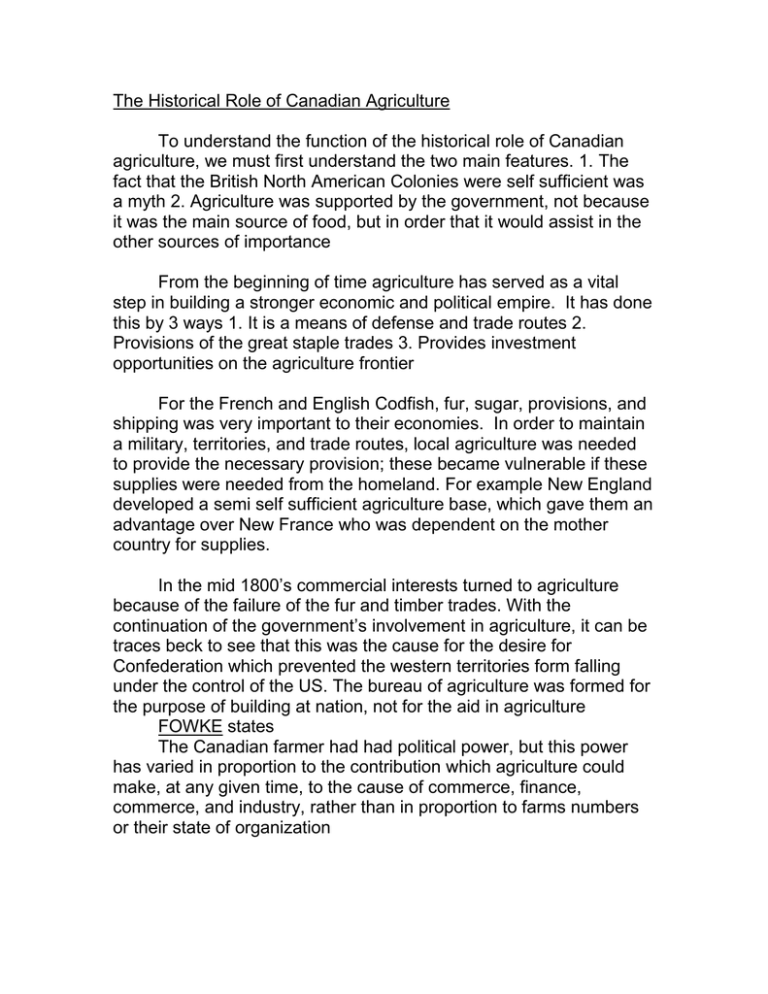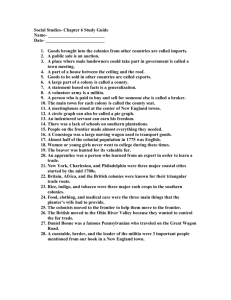The Historical Role of Canadian Agriculture
advertisement

The Historical Role of Canadian Agriculture To understand the function of the historical role of Canadian agriculture, we must first understand the two main features. 1. The fact that the British North American Colonies were self sufficient was a myth 2. Agriculture was supported by the government, not because it was the main source of food, but in order that it would assist in the other sources of importance From the beginning of time agriculture has served as a vital step in building a stronger economic and political empire. It has done this by 3 ways 1. It is a means of defense and trade routes 2. Provisions of the great staple trades 3. Provides investment opportunities on the agriculture frontier For the French and English Codfish, fur, sugar, provisions, and shipping was very important to their economies. In order to maintain a military, territories, and trade routes, local agriculture was needed to provide the necessary provision; these became vulnerable if these supplies were needed from the homeland. For example New England developed a semi self sufficient agriculture base, which gave them an advantage over New France who was dependent on the mother country for supplies. In the mid 1800’s commercial interests turned to agriculture because of the failure of the fur and timber trades. With the continuation of the government’s involvement in agriculture, it can be traces beck to see that this was the cause for the desire for Confederation which prevented the western territories form falling under the control of the US. The bureau of agriculture was formed for the purpose of building at nation, not for the aid in agriculture FOWKE states The Canadian farmer had had political power, but this power has varied in proportion to the contribution which agriculture could make, at any given time, to the cause of commerce, finance, commerce, and industry, rather than in proportion to farms numbers or their state of organization French Agriculture in New France Europe started to settle in New World. These new colonies were developed to serve the interests of the Mother Country. The fur, and cod trade were the two main resources. These commodities contributed to the trade with Spain. Trading with Spain was very important to everyone because of there latest uncover of large amounts of gold. And a positive trade balance with them would bring gold into the coffers of England, France, and Holland. So at this time agriculture was not of any importance. Any completion with the fur and cod trade would not be tolerated. This was proven when the explore Cartier traveled to the new world he found agriculture all along the St. Lawrence, then ¾ of a century later no agriculture settlements were found. People were more interested in fur and cod trade that seemed limitless. The beginning of agriculture in New France started around 1598 by a man named Marquis de la Roche. He was appointed lieutenant-general and governor of the French territories. He also was give the power to grant land in seigniories, which means “ to be held in such a manner as he shall deem in keeping with services and on such terms and conditions as shall conduce to the defense of the said countries”. So agriculture at this time was to provide only as a means of defense. The farmers were used to protect the fur trade routes. This was a quick way to raise an army rather than waiting for them to arrive form Europe. Roche also realized that agriculture could be used to strengthen the cod and fur trade by producing food within the colonies. This would cost considerably less than if the food was bought from over seas. Inspire of various forms of assistance, the French governments efforts to developed agriculture in the Canadian colonies were relatively unsuccessful. An indication of the limited degree of success was the fact that much of the food required to maintain the staple industries continued to be bought from France. This would lead to the colonies demise. With the French and English colonies so closely together and competing for the same goods, conflict was inevitable. The treaty of Utrecht in 1713 required the French to with draw from the area called Acadia. In this area agriculture was finally starting to take hold. The French were restricted on where they could hunt and fish and tried to make a go of agriculture again but with the final fall of Quebec, clearly indicated the French failure of agriculture in the New World. Most of the French settlers sold there land and returned to Europe following the conquest. The St. Lawrence Region under English Control. Once the British took control of the French colonies they became enthusiastic about the agriculture potential of the area. They wanted to expand the production of the growing of hemp and manufacturing of potash. These items were in great demand in Britain. Hemp was encouraged to be grown in a number of ways. 1. Prices were fixed for locally grown hemp 2. Bounties were on land planted in hemp 2. Premiums for the largest field, best fiber and seed. Despite all of this assistance Canadian hemp productions never really contributed to British supplies. The reason for this is because to grow hemp is easy but its final product was very labor intensive which the colonies lacked. Special government offers were given to new settlers but this failed. James Murry was appointed Governor and was excited about agriculture in the area. He tried to promote settlement in the area by advertising in American papers and offering large settlement offers but the fur trade route restricted this. The only 2 motives for merchants in the area were to feed and clothe the troops and the fur trade. Agriculture in the area was not appealing to the people. But governor Murry would set the stage for British agriculture policy Quote Upper and Lower Canada When the government tried to develop agriculture they made grants of land, encouraged immigration, gave bounties, and made much use of agricultural societies to distribute these bounties and to effect improvements in methods of production. The enthusiasm to develop agriculture varied so its evolution was a relatively uneven process; it was not until the establishment of a Bureau of Agriculture for Upper and Lower Canada in 1852 that agriculture was recognized as an important industry. The Key factor which made the switch to agriculture in the colonies was the failure of the fur trade. People were looking for a new trade so they turned to wheat, timber and potash. As production increased, it placed downward pressure on British prices, wages, and land values which led t Britain closing the markets to the colonies. The farmers had no markets for their produce, this led to British aid which they gave grants to the colonist farmers. On the trade side of agriculture, farmers favored tariffs and the protection of agriculture while merchants wanted free trade. Merchants only care about themselves and cheap produce. They would not tolerate anything that threatened their prosperity. In 1840 tariffs were applied against American farm produce which was not a victory for the Canadian farmers but was designed to encourage the removal or reduction of US tariffs. At this point the tariffs were designed to protect agriculture but it was not needed. The supply exceeded the demand and Canada was exporting so the tariffs were more of a hinder than a help. As the commercial interests began to fail Canadian agriculture took on a new importance and a new role. Canada was having economic problems and the only solution to this was immigration. Immigration involved settlement, settlement required manufacture goods, tools and implements as well as capital and investment. Therefore the frontier role of agriculture was to create investment opportunities. The Agricultural Frontier World – wide depression, European and British crop failure, local crop failures, and commercial difficulties had created distress and unrest in British North America. This led to a desire in Canada for closer ties with America. Two problems had to be over come for this to happen. 1. Transportation had to be improved and 2. Trade had to be liberalized. In 1848 the St. Lawrence Canals were completed to draw the trade of the western states but the high freight rates deterred this. To make matters worse, the Canadian soils were becoming exhausted and the march of pests such as the wheat midge, the Hessian fly and the emergence of a new fungus to the new world, “rust”. This resulted for a greater effort to improve agricultural production in Canada. The US was involved in a civil war and these events provided a very profitable environment for merchants, transportation companies and producers.




